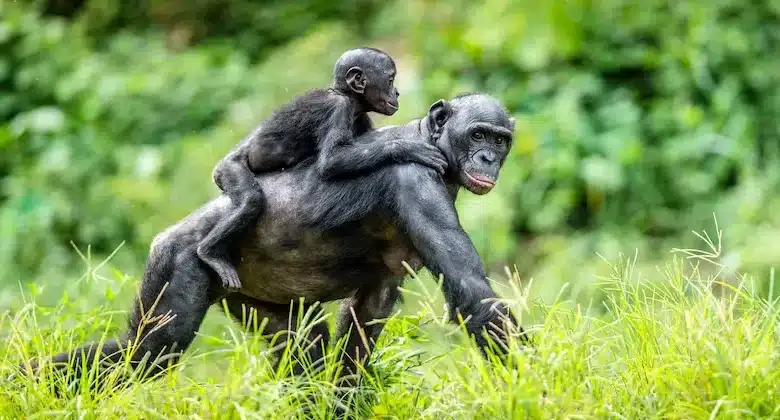Endangered Rainforest Species: Chimps & Bonobos

People tend to think of the chimpanzee as being a cute, and rather small, humanlike animal. That misconception is no doubt owed to the fact that baby and juvenile chimps make most of the species’ frequent television appearances. In fact, an adult male chimp, at well over 5 (1.5m) feet tall and weighing as much as 150 pounds (70kg) is far stronger than an adult male human, not necessarily playful, and quite dangerous if provoked.
Chimps live in and near the fast-disappearing rainforests of western and central Africa. They are listed as an Endangered species, with a population of perhaps 250,000 remaining, down from the 1 to 2 million of the apes that roamed the forests of 25 African countries at the turn of the 20th century.
Chimps live in mixed groups of adult males and females and their offspring. The adult males frequently struggle with one another for dominance, often forming alliances as they do so. The females also work out a status order or hierarchy among themselves. Sexually receptive females will usually mate with several males in their group.
Chimpanzees have been documented making and using a variety of tools for gathering or eating food. Male chimps have also been seen hunting monkeys and other animals, as well as forming “war parties” to attack and kill members of neighboring bands of chimpanzees. See a short video about chimpanzee tool use.
Endangered Rainforest Bonobos
Appearance wise, there is not a great deal of difference between the bonobo, or “gracile chimpanzee” (Pan paniscus) and the common chimpanzee. The bonobo is a bit slighter of frame, hence the “gracile” description.
But in behavior, the two species could hardly be more different. Bonobos have famously been described as lovers rather than fighters. Males neither dominate the females nor make war on neighboring groups of bonobos. Instead, according to scientific observers, they seem to channel most of their excess energy into frequent, and promiscuous, sexual activity.
Perhaps 50,000 bonobos remain in a single, but sizable, area of Congo. The threats to bonobos are the same as those to common chimpanzees and gorillas: habitat destruction, illegal market hunting and human diseases such as the Ebola virus.
SEE: A MAP OF WHERE THE BONOBO LIVES
READ:WHERE DO CHIMPS LIVE?
READ:WHAT DO CHIMPS EAT?
BACK TO THE RAINFOREST PRIMATES PAGE
